![[Culture & Arts]](Culture%20&%20Arts.jpg)
A candid account and insightful reflections by literati
Ranga Chandrarathne
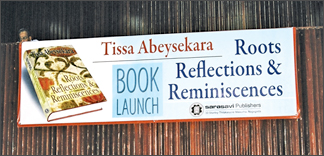 BOOK LAUNCH: Tissa Abeysekara’s seminal work titled “Roots,
Reflections & Reminiscences “was recently launched marking yet another
important milestone in Tissa Abesekara’s trail-brazing career as
bi-lingual author. BOOK LAUNCH: Tissa Abeysekara’s seminal work titled “Roots,
Reflections & Reminiscences “was recently launched marking yet another
important milestone in Tissa Abesekara’s trail-brazing career as
bi-lingual author.
Being perhaps the most famous contemporary bi-lingual in Sri Lanka,
Abeysekera is not from the academia although several Sri Lankan writers
wrote in English such as Martin Wickremasinghe. However, by his own
admission, Wickremasinghe had never been at ease with English and most
of his English writings were confined to articles on literature and
anthropology.
Tissa is at ease with both Sinhala and English and won a most
prestigious literary award for English in Sri Lanka; the Gratiaen prize
for his novell ‘Bringing Tony Home’.
|

BI-LINGUAL AUTHOR: Tissa Abeysekara at the book launch |
However, the singular characteristic of Abesekara’s writing in both
Sinhala and English is that he is able to express his heart and mind in
a most natural way, with diction unique to him, which is more or less
close to famous English essayists such as Virginia Woolf and the prose
of Somerset Maugham.
Tissa Devendra in his introductory remarks at the launch stated that,
“Tissa comes from a split social background. His father was from the
Anglicised upper middle class whilst his mother hails from an
exclusively Sinhalese speaking lower middle class with roots in rural
hinterlands of our country.
Tissa is a fusion. On occasions, an uncomfortable and an uneasy
fusion of these two strands. But Tissa has, like any gifted human being,
confusing social circumstances. He is one of the giants of that
vanishing, if not vanished, bi-lingual intelligentsia of our country.”
Reggie Siriwardene, observed that, “in Tissa’s creative writing in
English, the language of our colonial rulers, has acquired, and for the
first time, a distinctly Sri Lankan tone.”
The book, which runs into 264 pages, has been divided into three main
sections; Roots, Reflections and Reminiscences. It contains articles by
the author, which had appeared on newspapers and numerous presentations.
Tissa’s reflections on diverse subjects ranging from cinema to his life
and times are also presented.
In the chapter “Fifty-Fifty of the Species” which is a presentation
of the author read at the SAARC Writers’ Conference held in Lahore,
Tissa traces back to the very commencement of Sri Lankan writers in
English and of writers in English from SAARC countries.
Abeysekera states “...Thus we preened ourselves on our ability to
speak English properly and found the English spoken with Tamil accent,
cause for laughter. Those were the times when ethnicity had not yet
reared its poisonous hood, and both Sinhalese and Tamils laughed
together good-naturedly.
There was a man who wrote in English in the nineteenth century; he
was a Sinhala, an official of the rank in the Colonial administration,
and his name was Dandris de Silva Gooneratne. He wrote an essay on
Demonology to the Royal Asiatic Journal of 1868, and it immediately
acquired seminal status.
Lord Macaulay, read the essay, and was impressed enough to write to
Dandris de Silva personally.
In the letter, the imperial agent observed thus: Of all my imitators,
writing in English, you seem to have come closer to stimulating basic
elements of my style. Dandris Silva was immediately christened as
‘Ceylon Macaulay’.
......Even though Ceylon had a writer who wrote as well as Macaulay
as far back as 1864, our first great candidate for serious critical
attention in the world of English creative writing, Michael Ondaatje -
emerged only in the eighties.”
Abeysekera also states that although Sri Lanka produced a number of
outstanding scholars and scholarly writing in English, they all wrote
“from the head and something was missing. The problem was not one of
learning the language, or mastering its vocabulary, its grammar and its
syntax. The challenge was to integrate language into one’s thinking. It
is here that both Mulkraj Anand and Bankim Chandra Chatterjee of India,
and Lucian de Zylwa of Sri Lanka failed.”
This is a fact that most of us conveniently forget that language
whether foreign or mother tongue that the language should be integrated
into one’s thinking and that one should be able to express in a natural
manner, perhaps, with heart and mind.
Among the fascinating chapter in the section “Reminiscences “is the
chapter on Martin Wickremasinghe. It is here that Tissa Abeysekera
explains his quest in search of his roots and the vital role the
language plays in a culture.
“More than his novels, reminiscence like Apey Gama, voyage of
cultural discovery like Kalu Nika Seveema, intellectual quest like,
Sinhala Lakuna, and awesome treatises like Sinhala Sahitayaye Negeema,
conquered me completely.
I was slowly discovering my roots, tracing the contours of my
fractured cultural heritage and learning a principle which continued to
guide me - the importance of language in culture.”
The book is a must read for deserving readers who cherishes the
cultural baggage the bygone era bequeathed us. It is also the reflection
of the contemporary cultural history of Sri Lanka where the cultural
scene was dominated by bi-linguals who nourished the vernacular
languages as well as the language of their adaptation that is invariably
the Colonial master’s language English.
Picture by Palitha Gunasena
Smt. Bindu Juneja’s visit to Sri Lanka
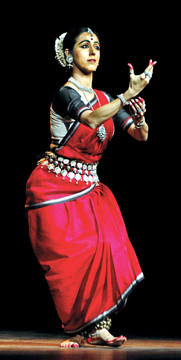 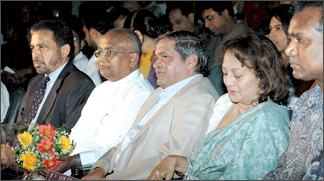 DANCE: Smt. Bindu Juneja, the renowned Odissi dancer from
India and her troupe performed in Sri Lanka recently. DANCE: Smt. Bindu Juneja, the renowned Odissi dancer from
India and her troupe performed in Sri Lanka recently.
Her visit was sponsored by the High Commission of India in Sri Lanka
and the Indian Council for Cultural Relations (ICCR) to celebrate the
60th anniversary of India’s Independence.
Initially trained in Bharatha Natyam, in her childhood, at the
Bhatkhande Sangeet Mahavidyalaya, Lucknow, Bindu Juneja was soon drawn
towards the fluidity and lyrical mysticism of Odissi. She received
training in the style from its eminent exponent Madhavi Mudgal at the
Gandharva Mahavidyalaya, New Delhi.
Bindu’s dance displays a fine classicism of expression which stems
from her rigorous training and a profound understanding of the
philosophy and aesthetics of Indian Art. She was also fortunate to have
been in close proximity with Guru Kelucharan Mahapatra, the grand
maestro of Odissi, and imbibe the deeper nuances of his art. In her
pursuit of oneness with the dance form, she has emerged a sensitive and
refined exponent of Odissi.
 An “A” grade artiste of Doordharshan, Bindu has featured in several
national telecasts. She also has extensive experience of performing both
within and outside India. She has performed in several prestigious
festivals in the country. An “A” grade artiste of Doordharshan, Bindu has featured in several
national telecasts. She also has extensive experience of performing both
within and outside India. She has performed in several prestigious
festivals in the country.
Her performance tours abroad have been to the USA for the Festival of
India in 1986, Mexico, the Slovak Republic, Sweden, Hungary, Vienna,
Germany, France, Holland, Spain, Brazil and United Kingdom.
She has been a recipient of the “Junior Research Fellowship” from the
Department of Culture, Government of India and also its production grant
for a thematic presentation entitled “Sakshatkar Unravelling the True
Nature of Lord Jagannath”. Presently she trains students in her own
dance studio Parn in Bhopal.
Pictures by Saman Sri Wedage
Teleview pioneers in high definition television technology
|

PIONEER: Sunil Ratnayake, Managing director of Teleview (Pvt)
Ltd
Picture by Saman Sri Wedage
|
AMBITION: In a period which demands changes and new ideas only
a few have the tendency to survive or proceed. Teleview (Pvt) Ltd, the
oldest production house in Sri Lanka sets a good example to this view.
Incepted in 1983 the company had emerged as a winner from among many
in the competitive field. Their secret lies in readjusting themselves
according to the demands of the era.
“We are in a creative business field. This is an industry and we
approach our field from within this scope,” observed the managing
director of Teleview, Sunil Ratnayake.
Teleview had passed many a milestone in their journey to the present.
The company had clinched a large number of awards for its creations.
Outstanding amongst them is the number of awards claimed by the popular
teledrama,Dandubasnamanaya, 20 out of 24 which is a record itself alone.
Their science fiction teledrama Bhawathra won a special award of
excellence at the Sumathi Tele Awards last year while it won a lot of
praise at the Rigam Tele Awards festival as well.
|
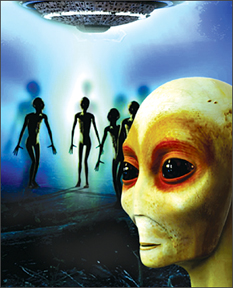
SCIENCE FICTION TELEDRAMA: A still from Bhawatra |
|
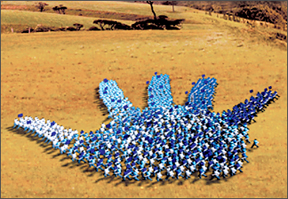
TECHNOLICAL CREATION: A part of the Mobitel advertisement which
was created using the method of ‘Crowd duplication’ |
Furthermore the company won recognition as the Achievers Awards
presented by the Ceylon National Chambers of Commerce, the best
provincial and National Award for best Entrepreneur was awarded to them.
In Teleview creativity, business and technology go hand in hand. This
was evident as the company used the method of crowd duplication in
making the hand for the Mobitel advertisement.
“There are 10 world’s best visual effects and we are already using
eight and a half of them. They are 3D and 2D MATT painting, visual
pasting, Digital Sets Construction, Digital editing, Digital camera
tracking, Crowd or Simulation duplicating, Wire (character) removing,
Rotoscoping and Manual motion capture. We have also instilled an academy
called the Teleview Technology Academy,” Ratnayake explained.
“Teleview is an operating academy with a host of different sections.
We make teledramas, commercials and documentaries and we are now running
a video village in Badulla and developing another in Maharagama.”
A video village is a number of functions in one unit. According to
Ratnayake there is no need to construct the background required for each
scene in different places because the video village possesses it all.
The celebrated science fiction teledrama Bhawathra, a 55 episode tele
drama, was done using just two locations.
“Normally a teledrama of around 50 episodes needs about 200 locations
but we used digital technology for this purpose. If you need to shoot a
scene in a temple the video village already has a temple.
|

MOMENT OF GLORY: Rebecca Kohn, the country director of USAID
hands over the Achievers Award to Ratnayake at the Achievers
award Ceremony |
If it is a mansion that you need there is already a big house in the
video village to use for those scenes. It is quite easy. All you need to
do is set the equipment, get the actors and actresses and start
shooting,” he pointed out adding that if a problem arises there is no
need for cancellations.
The team can shift the day’s shooting to another scene in another
background within the same area and start shooting as all the necessary
equipment are stored within the video village.
“Postponements were regular in the past thereby costing us a lot of
money. Now that problem is solved since we have all the functions handy.
We are now on the verge of approaching the home entertainment sector as
well as the rural marketing unit. Our main aim is to approach the
international division.”
Teleview hopes to gain their objective by supplying programmes for
international broadcasting. They are planning to co-produce programmes
with foreign artists. They have already had the experience of acting as
service providers for the French tele series named ‘Tea Garden’.
“We need to recognise the requirements of the international field and
develop programmes on those interests. Cultural activities of a country
draw a lot of interest so our first step would probably concern
documentaries of that nature.”
The company has already planned on three projects for the future. One
is a tele series named Asahin Eha (Beyond the sky), a story with a
number of war episodes and digital animated alien characters, all of
which require the help of visual effects. Coming up next will be a local
x - files series based mostly on true facts with dramatic presentations.
Closely following would be a creation based on King Sri
Wickramarajasinghe.
“We will not be creating the gold and silver palace of that time.
Those effects will be given using technology. We need to approach tele
series from a different angle and ever since our inception we have
followed a different path from the rest. We have already produced the
most number of tele series in the field and now we are in the process of
re - engineering our divisions to suit the demands of the modern era,”
Ratnayake pointed out adding that the field is a good importing
industry.
“We possess the talent but we are trying to find a breakthrough into
the international network. There are many television channels throughout
the world and they are always looking for interesting programmes to
cater to their audience. We have picked our targets. We are setting the
foundation to our plans.”
 Takes stage at Bishop’s College Takes stage at Bishop’s College
MUSIC: Apeksha, a two hour performance of various ages and
different costumes and settings will be performed at the Bishop’s
College Auditorium on August 23 at 7 p.m. The evening starts with a
percussion rendition of “Thamattam gee nade” when children dressed up
like Sri Lanka from both ethnic communities will walk up on stage.
After welcoming the audience, a 40-member choir will sing a song
depicting the pathos of the human predicament while Pharaoh whipping
slaves in ancient Egypt takes foreground.
This will be followed by a powerful voice when the solo item is sung
by
Havindra Gunewardene. The next item will be a ‘Sea Dance’ performed
by over 20 children. Next is a contemporary fusion dance led by teenage
Avishka and her gang of girls.
The TGIF (Thank God It’s Friday!) youth group will then perform a
short
drama themed ‘The divide’. Twenty boys and girls, aged 18-20 will
mime as the group gets divided on fighting for what belongs to them. The
Revolution will then shout out, when the Sinhala youth charge on to the
stage and appeal to the youth with their item ‘Soyurane’.
Over 20 children from the Rainbow House orphanage at Kelaniya will
then take the centre stage and perform a dance item. This will be
followed by children of the war from the Trincomalee orphanage. All the
children are orphaned Tamil children.
The choir will again come on stage for a song and then the female
soloist, Dilrukshi Perera will sing a Sinhala song of Apeksha. Seshan
and crew will sing hauntingly enrapturing song “Beauty for brokenness”.
Next, the hall will be darkened when a lone soldier comes to the
realisation of himself and where he stands in what he believes.
To the hushed audience, Dr. Hiranthini de Silva will then give ‘My
tribute’. After Dr. Lalith Mendis spends a few minutes on ‘The Promise’,
the night will ring out with the melody of the female vocalist Sabrina
Gunetilleke when she sings of ‘The Mighty Hands’.
This will be followed by a Sinhala soliloquy, ‘Oba nomathi dinayak.’
Then, Havindra Gunewardene’s powerful baritone voice will resonate
with how
‘God will make a Way’.
Ethnic harmony and unity will become stronger with ‘Mullulla’, a
Tamil song on the rose and thorns.
The evening will draw to a close when Seshan Gunetilleke leads the
choir
with the powerful song, “Peace be to these Streets.” This will be
followed by the finale, where everyone joins in to wish for Sri Lanka.
Sinhala items will be produced by Anuruddha Fernando. The evening is
choreographed and directed by Nirmal Peiris and Manique Nanayakkara.
Music is directed by Seshan Gunetilleke. Lalindra Nanayakkara will be
responsible for the visual effects. The stage set has tiers. Lighting on
the sides will change according to the mood of the item.
The professional lighting overall will set the moods of each item
while digital back projection will back up the centre stage action on
giant screens on either side and the centre of stage. Music will have
electric drums, guitars, keyboards as well as Sri Lankan percussion
instruments like bera and thammatta.
At present, the cast is practicing everyday and joyfully looking
forward to the event. Though many are tired by the rigorous schedule,
they come eagerly the next day, to perfect their items.
Multiple practices happen at the same place. Sometimes, when one
group
practices the rhythms to the live sounds of the band, another group
plays the MP3 version of their song on the Nokia phone and go through
the steps and movements.
The Promise. It’s not just a performance. It’s something personal. It
will become something personal to those who come to see it.
The entire event is organised by the Concerned Professionals’ Forum.
The participants are mainly, members who are from secular jobs from
banking to marketing, to advertising to government administration etc.
Some of them are also from specialised fields such as lawyers,
doctors, engineers, computer analysts, senior managers of corporates
etc. Therefore practices are conducted after work. Some even bring their
infant children as they practice for hours well into the night of each
day. |

